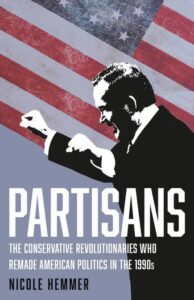If hard-line, race-based immigration restrictions were a deviation from the Reagan era, an opposition to Great Society civil rights and poverty programs, particularly those aimed at helping Black Americans, seemed very much like a continuation of it. But the new writing on Black Americans, inequality, and government intervention deviated sharply from Reagan’s libertarian-minded approach. Reagan asserted these programs failed because they were a matter of government overreach, interrupting the natural state of the market and social relations. He offered an optimistic (even Pollyannaish) view of what would exist without government interference: a colorblind, meritocratic, and equality-based society.
Writers like Charles Murray, Richard Herrnstein, and Dinesh D’Souza painted a much bleaker picture. When they looked at Black inequality—in wealth, in educational attainment, in life expectancy, in political power—they saw the root cause not as racism or ineffective government intervention but as problems that existed within the Black community—in Murray and Herrnstein’s case, an intelligence deficit; in D’Souza’s, a cultural one.
Those arguments would not only lay the groundwork for a more pessimistic, color-conscious racism on the right but also provide a more respectable version of anti-Black politics than that of someone like David Duke (who, for all his efforts to appear respectable, could never truly disassociate himself from the Klan).
Murray and Herrnstein’s The Bell Curve became an instant sensation when it hit shelves in 1994. In it, they offered a number of arguments about IQ, societal problems, and race. The core contentions were that IQ was, to a significant degree, heritable and unchangeable; that low IQ correlated to both race and negative social behaviors, leading to poverty, crime, and out-of-wedlock children; and that policy should take those correlations into account.
Though crammed full of charts and equations, The Bell Curve was not a scientific tract—the authors were a political scientist (Murray) and a psychologist (Herrnstein), not scientists or geneticists. It was instead a policy book that used poorly interpreted and dubiously sourced pseudoscientific data to build its arguments.
The new writing on Black Americans, inequality, and government intervention deviated sharply from Reagan’s libertarian-minded approach.
The Bell Curve was a broadside against the Great Society and a call for new policies that, while not explicitly race based, would have profound consequences for Black people and nonwhite immigrants. The authors called for, among other things, elimination of aid to poor mothers so they would stop having children; an end to the use of affirmative action in college admissions, which they argued raised low-IQ people of color above their ability levels; and a shift in immigration law from family-based immigration to merit-based immigration in order to favor higher-IQ immigrants.
These were not new ideas, of course. Scientific racism had been around for centuries, confidently asserting schema for racial classifications and racial superiority. Herrnstein himself had been on the race-IQ beat for almost a quarter century, part of a renaissance of scientific racism repackaged around contemporary intelligence research. In a 1971 piece for The Atlantic, he argued government spending on education and antipoverty programs could not promote equality, because they did not address racial groups’ inherited differences in IQ.
The article proved as influential as it was controversial. In the White House, Pat Buchanan, then an aide to President Richard Nixon, drafted a memo arguing against federal programs focused on integration and poverty. “The importance of this article is difficult to understate,” he wrote to the president, confusing “understate” with “overstate.” “If correct, then all our efforts and expenditures not only for ‘compensatory education’ but to provide an ‘equal chance at the starting line’ are guaranteeing that we wind up with the intelligent ones coming in first. And every study we have shows blacks 15 IQ points below whites on the average.”
Nixon sent the article to presidential counselor Daniel Patrick Moynihan, who a few years earlier had authored the Moynihan Report, which argued Black poverty was a function of failings in Black culture. Moynihan told the president that Herrnstein’s arguments rang true. Yet, while both men agreed with Herrnstein, in a private Oval Office conversation about the article, the sense of taboo hovered: “Nobody must think we’re thinking about it,” Nixon told Moynihan, “and…if we do find out it’s correct, we must never tell anybody.”
Nixon, whose racism is well documented, stressed that he hadn’t wanted to agree with Herrnstein and other race-IQ researchers like Arthur Jensen, but he ultimately did. “I’ve reluctantly concluded, based at least on the evidence presently before me, and I don’t base it on any scientific evidence, that what Herrnstein says, and what was said earlier by Jensen, and so forth, is probably very close to the truth.”
It mattered that Moynihan and Nixon did not declare their agreement with Herrnstein publicly. They may have agreed, but their agreement did not shape the public debate about social and economic programs. The trajectory for The Bell Curve was markedly different: controversial as it was, it entered mainstream political discourse and became part of the right’s conception of race, IQ, and policy.
D’Souza’s work fit into a developing discourse about race that centered on affirmative action, political correctness, and multiculturalism.
Like Herrnstein, Murray had begun influencing policy before the 1990s. His first book, Losing Ground, came out in 1984 and hewed closely to the Reagan line. In it, he directly attacked the Great Society’s antipoverty programs, arguing they increased poverty and inflicted moral damage on those who used them. Deliberately conflating poor people with Black people, he argued that despite the billions spent on poverty programs, the ranks of the poor had actually grown. The solution: end all affirmative action programs and all welfare for poor people of working age. The project was an instant hit within the conservative movement and the Reagan administration—and Bill Clinton would eventually profess agreement with it as well (his Third Way politics were at times indistinguishable from Reaganism).
Both authors of The Bell Curve had trafficked in racist ideas before the book’s publication. Herrnstein’s were more explicitly racist, while Murray’s were subtler. Their shared dedication to finding ways to both explain away racism and undo Great Society programs brought them together for The Bell Curve, a book that pushed Murray in particular past a Reaganite critique of antipoverty programs and toward something more sinister.
Dinesh D’Souza, an immigrant from Mumbai who spent his years after college working in the Reagan administration, disagreed with Murray and Herrnstein’s conclusions—but not because he still clung to the Reaganite line. In a chapter of his 1995 book The End of Racism titled “The Content of Our Chromosomes,” he laid out Murray and Herrnstein’s argument, carefully picking through the controversy about race, intelligence, and genetics.
In the end, he agreed that the fifteen-point gap between white and Black Americans on IQ tests was significant and had serious implications for policy. But he disagreed that it was rooted in genetic difference. Instead, he argued that the issues were cultural: specifically, a failing of Black culture.
In The End of Racism, D’Souza insisted that structural racism was largely the invention of “race hustlers,” both inside the university and out, and that the ideology of multiculturalism and cultural relativism had poisoned discussions about race in the United States. He argued for the supremacy of Western (white) culture, maintaining that problems of high incarceration rates and poverty stemmed not from racist institutions but from a corruption at the heart of Black society, which he labeled “self-defeating” and “irresponsible.”
D’Souza described inner cities as places where “the streets are irrigated with alcohol, urine, and blood.” Racism, he argued, is simply “rational discrimination,” the ability of observers to detect that Black culture is worse than white culture. It was not racism but antiracism that was to blame for African Americans’ plight, he maintained, arguing that Black civil rights activists and white liberal Democrats had a vested interest in keeping “the black underclass” down.
D’Souza’s work fit into a developing discourse about race that centered on affirmative action, political correctness, and multiculturalism. Handwringing over multiculturalism became a national pastime in the 1990s, and not only on the right. The end of the Cold War triggered a fear of national disintegration as old empires and nation-states began unravelling. Not only had the former Soviet Union begun the process of breaking up, with a number of formerly occupied states gaining independence, but other non-Soviet states began to break apart as well, most notably Czechoslovakia and Yugoslavia.
In the 1991 book The Disuniting of America, liberal historian Arthur Schlesinger Jr. worried that the United States would encounter a similar type of shattering with the demise of a common culture, driven not just by migration from across the globe but by ideas of multiculturalism that celebrated the presence of distinct cultures rather than emphasizing assimilation into the dominant one, something he called the “cult of ethnicity.”
D’Souza stripped away the “burden,” such as it was, arguing that it was up to Black Americans to lift themselves from what he saw as a bankrupt culture.
The most energetic rejections of multiculturalism, though, came from the right. A flood of books, including D’Souza’s Illiberal Education, which spent fifteen weeks on the best-seller list, railed against the ideas of multiculturalism and diversity. The authors believed such ideas had not only infected US higher education but were seeping into the culture at large. They saw these ideas as a threat to America itself: challenging the notion that Western civilization, with the United States as its greatest practitioner and defender, was the superior culture. To battle back against these ideas, they began to argue that racial differences not only existed but presented a genuine threat to white Western culture.
Like Murray and Brimelow, D’Souza cloaked his arguments in academic garb: extensive citations, lengthy expositions, detailed history. And like their books, The End of Racism was about promoting conservative policy, starting with the premise that the problems Black Americans faced were not the result of racism and that no outside intervention—especially not affirmative action—could solve them. He even recommended repealing the Civil Rights Act of 1964, arguing that nondiscrimination laws should only apply to the government, leaving the private realm to discriminate as it saw fit.
D’Souza’s argument was a reversal of the “white man’s burden.” In the late nineteenth and early twentieth centuries, British and American colonizers believed that, because they had built a superior culture, they were duty bound to awaken nonwhite civilizations to the wonders of Christianity and capitalism (normally at the cost of those civilizations’ material resources and sovereignty). But D’Souza stripped away the “burden,” such as it was, arguing that it was up to Black Americans to lift themselves from what he saw as a bankrupt culture.
Just as Brimelow had leveraged his identity as an immigrant to write about immigration, D’Souza used his nonwhite identity as a shield against charges of racism. “As a ‘person of color,’” he wrote in the introduction, “I enjoy an element of ethnic immunity that allows me to address topics with a frankness that would be impossible on the part of a white male.” He acknowledged that his arguments would be useful to opponents of equal rights but concluded that was a price that had to be paid to tell the truth.
And like Murray and Brimelow, he was handsomely rewarded. Taking on “taboo issues,” as D’Souza described them, turned out to be a profitable project. And that particular blend used by all three books—pairing incendiary ideas about race with the appearance of scholarly rigor—turned out to be the perfect way to gain attention from the mainstream press and emerge as a star of the new post-Reagan right.
___________________________________

Excerpted from Partisans: The Conservative Revolutionaries Who Remade American Politics in the 1990s by Nicole Hemmer. Copyright © 2022. Available from Basic Books, an imprint of Hachette Book Group, Inc.
